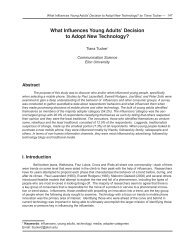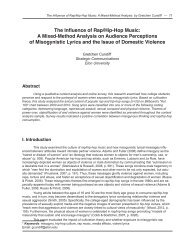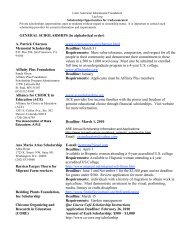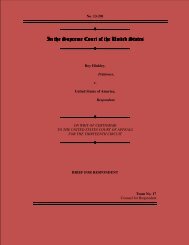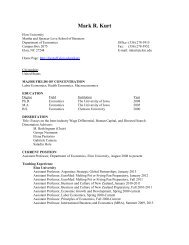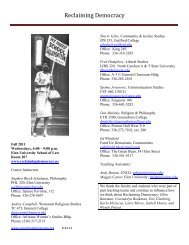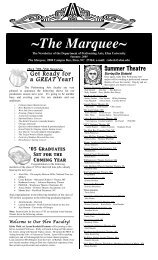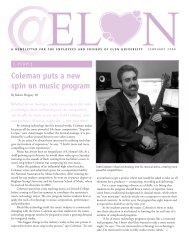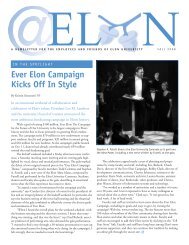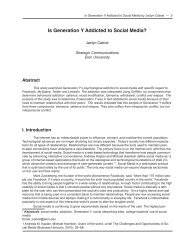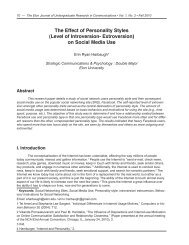Music in the Digital Age: The Emergence of Digital ... - Elon University
Music in the Digital Age: The Emergence of Digital ... - Elon University
Music in the Digital Age: The Emergence of Digital ... - Elon University
You also want an ePaper? Increase the reach of your titles
YUMPU automatically turns print PDFs into web optimized ePapers that Google loves.
112 — <strong>The</strong> <strong>Elon</strong> Journal <strong>of</strong> Undergraduate Research <strong>in</strong> Communications • Vol. 1, No. 2 • Fall 2010<br />
Abstract<br />
<strong>Music</strong> <strong>in</strong> <strong>the</strong> <strong>Digital</strong> <strong>Age</strong>:<br />
<strong>The</strong> <strong>Emergence</strong> <strong>of</strong> <strong>Digital</strong> <strong>Music</strong> and<br />
Its Repercussions on <strong>the</strong> <strong>Music</strong> Industry<br />
Sadie A. Stafford *<br />
Senior Major<strong>in</strong>g <strong>in</strong> Broadcast and New Media<br />
<strong>Elon</strong> <strong>University</strong><br />
<strong>The</strong> clearly ubiquitous evolution <strong>of</strong> digital music has created an apparent and drastic shift <strong>in</strong> <strong>the</strong> way<br />
consumers and producers view and use <strong>the</strong> music <strong>in</strong>dustry. <strong>The</strong> presence <strong>of</strong> <strong>the</strong>se music files that have been<br />
digitally compressed, thus mak<strong>in</strong>g <strong>the</strong>m easily atta<strong>in</strong>able to all for a small fee or illegally downloaded for free,<br />
has made <strong>the</strong> music <strong>in</strong>dustry reevaluate how <strong>the</strong>y are to make a pr<strong>of</strong>it <strong>of</strong>f <strong>the</strong>ir art form. Social media web<br />
sites have also created a visible demand from consumers for artists to ma<strong>in</strong>ta<strong>in</strong> a consumer-artist digital relationship,<br />
mak<strong>in</strong>g <strong>the</strong> Internet not only a promotional vehicle for artists, but also a necessity for pr<strong>of</strong>it. <strong>The</strong>se<br />
new means <strong>of</strong> music distribut<strong>in</strong>g and market<strong>in</strong>g have not only pushed <strong>the</strong> music <strong>in</strong>dustry to new levels, but<br />
has created a whirlw<strong>in</strong>d <strong>of</strong> changes as record labels are los<strong>in</strong>g control, with artists and consumers hav<strong>in</strong>g <strong>the</strong><br />
upper hand.<br />
I. Introduction<br />
<strong>The</strong> <strong>in</strong>spirational Bob Marley once said, “One good th<strong>in</strong>g about music, is that when it hits you, you<br />
feel no pa<strong>in</strong>.” But <strong>in</strong> our current state <strong>of</strong> be<strong>in</strong>g <strong>in</strong> a digital age, it is <strong>the</strong> music and <strong>the</strong> people who create this<br />
music that seem to be feel<strong>in</strong>g all <strong>the</strong> pa<strong>in</strong>. As <strong>the</strong> digital age encroaches on our lives, consumers are demand<strong>in</strong>g<br />
<strong>the</strong> music <strong>in</strong>dustry to keep up with <strong>the</strong>se changes, which <strong>in</strong> turn, has led to f<strong>in</strong>ancially devastat<strong>in</strong>g consequences<br />
for this <strong>in</strong>dustry. In a world that is full <strong>of</strong> conflict, economic despair, war and constant turbulence<br />
among nations, <strong>the</strong>re is only one entity that few can say <strong>the</strong>y genu<strong>in</strong>ely hate and that is music. <strong>Music</strong> is an<br />
<strong>in</strong>tegral part <strong>of</strong> our society as well as a part <strong>of</strong> societies throughout <strong>the</strong> world. It is art that strives to feed <strong>the</strong><br />
soul and pa<strong>in</strong>t a canopy <strong>of</strong> emotions through song. With this be<strong>in</strong>g said, it is important to note that we have<br />
reached a time when music has become so easily atta<strong>in</strong>able that anyone who has a computer can potentially<br />
become an overnight phenomenon. Much <strong>of</strong> this shift can be attributed to <strong>the</strong> digital age and its undeniable<br />
presence <strong>in</strong> <strong>the</strong> music world. Accord<strong>in</strong>g to Rick Carnes, president <strong>of</strong> <strong>the</strong> Songwriters Guild <strong>of</strong> America, “<strong>Digital</strong><br />
music has become <strong>the</strong> ubiquitous soundtrack <strong>of</strong> American life”(DiMA, 2008). This rapid emergence <strong>of</strong> new<br />
technologies has caused huge alterations <strong>in</strong> what was once a straightforward bus<strong>in</strong>ess model for success <strong>in</strong><br />
<strong>the</strong> music <strong>in</strong>dustry, caus<strong>in</strong>g many <strong>in</strong>dustry leaders to take a second look at how to tackle <strong>the</strong>ir art form.<br />
Is <strong>the</strong> digital age caus<strong>in</strong>g <strong>the</strong> creation and distribution <strong>of</strong> music to be so simple that <strong>the</strong> value is<br />
dim<strong>in</strong>ish<strong>in</strong>g? Does our obsessive Internet usage lend itself towards a shr<strong>in</strong>k<strong>in</strong>g level <strong>of</strong> respect for music art-<br />
* Keywords: <strong>Digital</strong> <strong>Age</strong>, <strong>Music</strong> Industry, Social Network<strong>in</strong>g, Interactive <strong>Music</strong> Market<strong>in</strong>g, <strong>Music</strong> Pirat<strong>in</strong>g and<br />
Sampl<strong>in</strong>g<br />
Email: sadie.stafford45@gmail.com
<strong>Music</strong> <strong>in</strong> <strong>the</strong> <strong>Digital</strong> <strong>Age</strong> by Sadie Stafford — 113<br />
ists because practically anyone can become a music star? <strong>The</strong> digital age has created both a luxury and a<br />
monster for consumers and producers alike because it has come upon us so rapidly that at times, it seems to<br />
get ahead <strong>of</strong> what we know how to handle. This article will look to analyze <strong>the</strong> <strong>in</strong>troduction <strong>of</strong> new technologies<br />
<strong>in</strong> regards to music production through a literature review and expert <strong>in</strong>terviews, as well as <strong>in</strong>vestigate<br />
<strong>the</strong> <strong>in</strong>ventive market<strong>in</strong>g tools artists are now us<strong>in</strong>g to promote <strong>the</strong>ir music. But <strong>the</strong> true goal <strong>of</strong> this research<br />
is to see what repercussions this technology has on music artists and <strong>the</strong>ir labels and <strong>of</strong> course, what we can<br />
expect for <strong>the</strong> future <strong>of</strong> <strong>the</strong> music <strong>in</strong>dustry.<br />
As technology and new media advance and improve, so do <strong>the</strong> means for market<strong>in</strong>g and promot<strong>in</strong>g <strong>of</strong><br />
anyth<strong>in</strong>g and everyth<strong>in</strong>g. <strong>The</strong> music <strong>in</strong>dustry is no exception to this ever-chang<strong>in</strong>g whirlw<strong>in</strong>d that has scooped<br />
up artists and <strong>the</strong>ir music and has moved <strong>the</strong>m to an entirely different level <strong>of</strong> shar<strong>in</strong>g, purchas<strong>in</strong>g, market<strong>in</strong>g<br />
and distribut<strong>in</strong>g. <strong>The</strong> pressure consumers have placed on <strong>the</strong> music <strong>in</strong>dustry to keep up with <strong>the</strong>ir demands is<br />
enormous. It is expected that record companies and <strong>in</strong>dependent artists develop new means <strong>of</strong> communication<br />
and distribution <strong>of</strong> <strong>the</strong>ir music as <strong>the</strong> Internet and onl<strong>in</strong>e databases explode with popularity. In this digital<br />
age, labels are los<strong>in</strong>g much <strong>of</strong> <strong>the</strong>ir importance and artists are more capable <strong>of</strong> promot<strong>in</strong>g <strong>the</strong>mselves, grant<strong>in</strong>g<br />
<strong>the</strong>m more ownership over <strong>the</strong>ir own work (Halonen-Akatwijuka and Regner, 2004).<br />
II. <strong>Music</strong> Pirat<strong>in</strong>g and MP3’s<br />
<strong>The</strong> real growth <strong>in</strong> emerg<strong>in</strong>g technologies began <strong>in</strong> 1998 with <strong>the</strong> evolution <strong>of</strong> <strong>the</strong> MP3 player. This<br />
allowed for a new type <strong>of</strong> audio-compression that was at <strong>the</strong> time, a revolutionary means for listen<strong>in</strong>g to music.<br />
What <strong>the</strong> creators <strong>of</strong> MP3 files and music <strong>in</strong>dustry experts didn’t know was that this technology that <strong>the</strong>y<br />
thought would help <strong>the</strong>m, would actually hurt <strong>the</strong>m <strong>in</strong> <strong>the</strong> long run. By develop<strong>in</strong>g a type <strong>of</strong> music file that is so<br />
compressed it takes up less space yet ma<strong>in</strong>ta<strong>in</strong>s <strong>the</strong> <strong>in</strong>tegrity <strong>of</strong> <strong>the</strong> audio quality, music personnel predicted<br />
that this technology would make it much easier to distribute and enjoy music across many outlets (computers,<br />
iPods, MP3 players, etc.). But this creation actually led to <strong>the</strong> development <strong>of</strong> <strong>the</strong> <strong>in</strong>famous onl<strong>in</strong>e file shar<strong>in</strong>g<br />
sites such as Napster and KaZaa, <strong>in</strong>spir<strong>in</strong>g <strong>the</strong> birth <strong>of</strong> peer-to-peer (P2P) transfers <strong>of</strong> music free <strong>of</strong> charge.<br />
From <strong>the</strong> <strong>in</strong>troduction <strong>of</strong> <strong>the</strong>se file-shar<strong>in</strong>g sites, pirated music (or music downloaded illegally) skyrocketed.<br />
In attempts to combat this music “steal<strong>in</strong>g”, this <strong>in</strong>advertently led to <strong>the</strong> development <strong>of</strong> onl<strong>in</strong>e music stores<br />
such as iTunes <strong>in</strong> 2000 (Gopal, Lertwachara, Marsden & Telang, 2007). Because <strong>of</strong> <strong>the</strong>se ris<strong>in</strong>g technologies,<br />
not only are record labels look<strong>in</strong>g at new means <strong>of</strong> music distribution, but artists are also look<strong>in</strong>g at <strong>in</strong>novative<br />
and orig<strong>in</strong>al ways to market <strong>the</strong>mselves onl<strong>in</strong>e.<br />
Before all this though, it is important to look <strong>in</strong>to how <strong>the</strong> digital world has made a splash <strong>in</strong> <strong>the</strong> lives<br />
<strong>of</strong> musicians and labels <strong>in</strong> terms <strong>of</strong> P2P file shar<strong>in</strong>g. <strong>The</strong> ma<strong>in</strong> concern is not “how we play <strong>the</strong> music, but<br />
where it comes from and what we do with it.” (What’s <strong>the</strong> Controversy, whats<strong>the</strong>download.com). Accord<strong>in</strong>g to<br />
Jeffery Valisno <strong>of</strong> Bus<strong>in</strong>ess World, many believe that, “onl<strong>in</strong>e music has led to illegal shar<strong>in</strong>g <strong>of</strong> music files to<br />
<strong>the</strong> detriment <strong>of</strong> <strong>the</strong> <strong>in</strong>dustry” (Valisno, 2009). <strong>The</strong>se technologies have led to a decl<strong>in</strong>e <strong>in</strong> cost <strong>of</strong> music for<br />
consumers as well as an <strong>in</strong>crease <strong>in</strong> <strong>the</strong>ir knowledge <strong>of</strong> artists, which are two <strong>of</strong> <strong>the</strong> reasons why this P2P<br />
file shar<strong>in</strong>g has blossomed so quickly (Gopal, Lertwachara, Marsden & Telang, 2007). So although services<br />
such as iTunes are completely legal and actually promoted, it is what happens to <strong>the</strong> music after it lands <strong>in</strong><br />
<strong>the</strong> hands <strong>of</strong> <strong>the</strong> purchaser that music aficionados are worried about. Once that music leaves <strong>the</strong> hand <strong>of</strong> its<br />
owner <strong>in</strong> <strong>the</strong> form <strong>of</strong> a burned CD, on an iPod player or through a flash drive, it is considered stolen music<br />
and <strong>the</strong> artist will not receive a cent <strong>of</strong> pr<strong>of</strong>it. <strong>The</strong> <strong>in</strong>dividuals download<strong>in</strong>g <strong>the</strong>se music files are many times referred<br />
to as “free-riders”, who are “<strong>in</strong>dividuals who consume a public good without actually pay<strong>in</strong>g for it [which<br />
can] underm<strong>in</strong>e <strong>the</strong> market efficiencies” (Gopal and Bhattacharjee, 2006).<br />
This illegal file shar<strong>in</strong>g is not a m<strong>in</strong>ute problem, it is one that presents an <strong>in</strong>credible concern to many<br />
musicians and labels alike. Accord<strong>in</strong>g to <strong>the</strong> <strong>Digital</strong> <strong>Music</strong> Report 2009, “40 billion music files were illegally<br />
shared worldwide last year” (Valisno, 2009). This number is <strong>of</strong> course astound<strong>in</strong>g, but when one looks at <strong>the</strong><br />
f<strong>in</strong>ancial backlash <strong>of</strong> <strong>the</strong>se downloads, it is even more devastat<strong>in</strong>g to <strong>the</strong> music <strong>in</strong>dustry. Accord<strong>in</strong>g to <strong>the</strong><br />
Record<strong>in</strong>g Industry Association <strong>of</strong> America (RIAA), two k<strong>in</strong>ds <strong>of</strong> losses were attributed to piracy, “losses from<br />
street piracy- <strong>the</strong> manufacture and sale <strong>of</strong> counterfeit CDs- and losses from onl<strong>in</strong>e piracy” (RIAA Web Site<br />
FAQ). RIAA also obta<strong>in</strong>ed a report from <strong>the</strong> Institute for Policy Innovation that does a breakdown <strong>of</strong> how drastic<br />
<strong>the</strong> economic losses have been from <strong>the</strong>se forms <strong>of</strong> piracy. Accord<strong>in</strong>g to <strong>the</strong> site:<br />
Global music piracy causes $12.5 billion <strong>of</strong> economic losses every year, 71,060 U.S. jobs
114 — <strong>The</strong> <strong>Elon</strong> Journal <strong>of</strong> Undergraduate Research <strong>in</strong> Communications • Vol. 1, No. 2 • Fall 2010<br />
lost, a loss <strong>of</strong> $2.7 billion <strong>in</strong> workers’ earn<strong>in</strong>gs, and a loss <strong>of</strong> $422 million <strong>in</strong> tax revenues,<br />
$291 million <strong>in</strong> personal <strong>in</strong>come tax and $131 million <strong>in</strong> lost corporate <strong>in</strong>come and production<br />
taxes (RIAA Web Site FAQ).<br />
III. <strong>The</strong> Power <strong>of</strong> <strong>Music</strong> Sampl<strong>in</strong>g and Shar<strong>in</strong>g<br />
Due to music pirat<strong>in</strong>g, record companies are los<strong>in</strong>g money and many artists believe that this is <strong>in</strong>directly<br />
forc<strong>in</strong>g record companies to be more hesitant to take on new talent, preferr<strong>in</strong>g to stick with <strong>the</strong> talent<br />
<strong>the</strong>y have to dodge <strong>the</strong>ir losses (Valisno, 2009). Research done <strong>in</strong> <strong>the</strong> Chicago Journal titled Do Artists Benefit<br />
from Onl<strong>in</strong>e <strong>Music</strong> Shar<strong>in</strong>g concluded that “consumers are more likely to sample first ra<strong>the</strong>r than directly<br />
purchase” (Gopal and Bhattacharjee, 2006). This implies that sampl<strong>in</strong>g is <strong>the</strong> future to music sales and can<br />
be used as a “truth-revelation mechanism” to determ<strong>in</strong>e how a consumer values a piece <strong>of</strong> music. It was<br />
found that <strong>the</strong> more <strong>the</strong> consumer valued <strong>the</strong> artist, <strong>the</strong> more beneficial music sampl<strong>in</strong>g <strong>of</strong> that artist becomes<br />
for <strong>the</strong>m. If <strong>the</strong> consumer has relatively little vested <strong>in</strong>terest <strong>in</strong> <strong>the</strong> artist though, that sampl<strong>in</strong>g can turn <strong>in</strong>to<br />
decreased revenues for that particular artist and label because <strong>of</strong> pirat<strong>in</strong>g.<br />
<strong>The</strong> gravity <strong>of</strong> this music steal<strong>in</strong>g has forced <strong>the</strong> authorities to become <strong>in</strong>volved <strong>in</strong> attempts to br<strong>in</strong>g a<br />
stop to this uncontrollable <strong>the</strong>ft. Organizations like <strong>the</strong> Record<strong>in</strong>g Industry Association <strong>of</strong> America (RIAA), <strong>the</strong><br />
<strong>Digital</strong> Media Association (DiMA) and <strong>the</strong> National <strong>Music</strong> Publishers’ Association (NMPA) are actively search<strong>in</strong>g<br />
for ways to combat this threat to <strong>the</strong> music <strong>in</strong>dustry. For example, <strong>in</strong> <strong>the</strong> RIAA mission statement <strong>the</strong>y<br />
mention that <strong>the</strong>y “work to protect <strong>in</strong>tellectual property rights worldwide and <strong>the</strong> First Amendment rights <strong>of</strong> artists”<br />
(DiMA Press Release, 2008). In attempts to act upon <strong>the</strong>ir promises, RIAA has begun to <strong>in</strong>itiate lawsuits<br />
aga<strong>in</strong>st people that are illegally download<strong>in</strong>g music. <strong>The</strong> association stresses <strong>the</strong> fact that if you steal music<br />
onl<strong>in</strong>e, you might as well just go to <strong>the</strong> store and steal and actual CD because <strong>the</strong> difference between <strong>the</strong>se<br />
two choices is nonexistent.<br />
Ano<strong>the</strong>r <strong>in</strong>terest<strong>in</strong>g aspect <strong>of</strong> music shar<strong>in</strong>g and illegal download<strong>in</strong>g is how it has affected a songs<br />
survival time on <strong>the</strong> music charts. A study done by four college pr<strong>of</strong>essors called <strong>The</strong> Effect <strong>of</strong> <strong>Digital</strong> Shar<strong>in</strong>g<br />
Technologies on <strong>Music</strong> Markets looked <strong>in</strong>to this very topic. <strong>The</strong>y predicted that with <strong>the</strong> emergence <strong>of</strong> file<br />
shar<strong>in</strong>g, well-known artists would decrease <strong>in</strong> popularity (which <strong>the</strong>y refer to as “<strong>the</strong> dilution <strong>of</strong> <strong>the</strong> superstar<br />
effect”) and newer artists would emerge from below to produce chart hits. What <strong>the</strong>y found was slightly different<br />
than what <strong>the</strong>y expected. <strong>The</strong> study showed that shar<strong>in</strong>g has relatively little effect on top albums and <strong>the</strong>ir<br />
survival on <strong>the</strong> charts. Smaller, lesser-known artists on <strong>the</strong> o<strong>the</strong>r hand, are hurt from this shar<strong>in</strong>g and experience<br />
less sales than before P2P shar<strong>in</strong>g was developed. Because <strong>of</strong> this, m<strong>in</strong>or labels are look<strong>in</strong>g for ways to<br />
use file shar<strong>in</strong>g as a beneficial tool to “popularize <strong>the</strong>ir albums” as opposed to hurt <strong>the</strong>ir sales with pirated music<br />
downloads (Gopal, Lertwachara, Marsden and Telang 2007). This love-hate relationship, along with artists<br />
desire to enhance <strong>the</strong>ir “digital relationships” with consumers is all part <strong>of</strong> <strong>the</strong> new age <strong>of</strong> music, someth<strong>in</strong>g<br />
that is just on <strong>the</strong> verge <strong>of</strong> be<strong>in</strong>g explored.<br />
IV. What <strong>the</strong> <strong>Music</strong>ians Th<strong>in</strong>k<br />
Speak<strong>in</strong>g <strong>of</strong> artists, it is <strong>in</strong>terest<strong>in</strong>g to note where <strong>the</strong>y stand on this issue <strong>of</strong> illegal digital download<strong>in</strong>g<br />
because it is <strong>the</strong>m who are <strong>in</strong>evitably <strong>the</strong> ones affected by this issue. Obviously, a majority <strong>of</strong> <strong>the</strong> artists<br />
are opposed to this form <strong>of</strong> music listen<strong>in</strong>g because, “<strong>the</strong> more illegal download<strong>in</strong>g is tak<strong>in</strong>g <strong>of</strong>f, <strong>the</strong> more <strong>the</strong><br />
record companies are suffer<strong>in</strong>g, <strong>the</strong> more that <strong>the</strong>y’re only concentrat<strong>in</strong>g on <strong>the</strong> big artists” (Artist Buzz, www.<br />
whats<strong>the</strong>download.com). Bigger artists like John Legend believe that many people illegally download because<br />
consumers feel that artists as successful as Legend, Madonna or <strong>the</strong> Beatles don’t need more money so <strong>the</strong>y<br />
don’t see <strong>the</strong> big deal <strong>in</strong> download<strong>in</strong>g a few <strong>of</strong> <strong>the</strong>ir songs free <strong>of</strong> charge. But Legend po<strong>in</strong>ts out that “<strong>the</strong>re’s a<br />
whole <strong>in</strong>dustry that thrives <strong>of</strong>f <strong>of</strong> those 99 cents you pay for your download” (Artist Buzz, www.whats<strong>the</strong>download.com).<br />
Before all <strong>of</strong> this digital music existed, it was pretty common for children and young people to make<br />
mix tapes for <strong>the</strong>ir friends, but as Sarah McLachlan puts it, “It’s one th<strong>in</strong>g when we were kids and we made<br />
tapes for our friends <strong>of</strong> songs. But it went to five people and now it goes to an <strong>in</strong>f<strong>in</strong>ite amount <strong>of</strong> people”
<strong>Music</strong> <strong>in</strong> <strong>the</strong> <strong>Digital</strong> <strong>Age</strong> by Sadie Stafford — 115<br />
(Artist Buzz, www.whats<strong>the</strong>download.com). So <strong>the</strong> concern is not that people are shar<strong>in</strong>g one song with a<br />
few people; <strong>the</strong> problem is that once music files get onl<strong>in</strong>e, <strong>the</strong>re are an endless number <strong>of</strong> people who can<br />
access <strong>the</strong>m, which is just what people do. <strong>The</strong> RIAA clearly states on <strong>the</strong>ir Web site that, “we have embraced<br />
<strong>the</strong> technological advances that have allowed millions upon millions <strong>of</strong> people around <strong>the</strong> world to enjoy <strong>the</strong><br />
music we create. We want fans to enjoy <strong>the</strong>ir iPods, CD burners, and o<strong>the</strong>r devices, but we want <strong>the</strong>m to do<br />
so responsibly, respectfully, and with<strong>in</strong> <strong>the</strong> law.”<br />
Surpris<strong>in</strong>gly enough, <strong>the</strong>re are also artists who feel that this illegal download<strong>in</strong>g is somewhat <strong>of</strong> a<br />
good th<strong>in</strong>g and are completely supportive <strong>of</strong> <strong>the</strong> digital era <strong>of</strong> music. Piracy acts as promotion for an artist because<br />
once <strong>the</strong> consumer has downloaded an unknown song, it is said that <strong>the</strong>y are more likely to purchase<br />
someth<strong>in</strong>g from that artist <strong>in</strong> <strong>the</strong> future (Gopal and Bhattacharjee, 2006). <strong>The</strong> Black Eyed Peas for example<br />
believe that download<strong>in</strong>g music is a good way for newer artists to get <strong>the</strong>ir music out <strong>the</strong>re if <strong>the</strong>y don’t have<br />
a big record company back<strong>in</strong>g <strong>the</strong>m. <strong>The</strong> band feels that if people download a portion <strong>of</strong> an unknown bands<br />
music and enjoy it, <strong>the</strong>y will eventually purchase <strong>the</strong> whole CD or download <strong>the</strong>ir music legally to fur<strong>the</strong>r enjoy<br />
it. Jason Mraz also shares this same appreciation for illegal download<strong>in</strong>g <strong>in</strong> <strong>the</strong> sense that he can see some<br />
<strong>of</strong> <strong>the</strong> benefits it serves. “I can’t yet compla<strong>in</strong> about download<strong>in</strong>g because <strong>of</strong> my fan base,” says Mraz. “I<br />
would probably say half <strong>of</strong> my fan base that comes to our concerts, heard about me because <strong>of</strong> illegal download<strong>in</strong>g”<br />
(Artist Buzz, www.whats<strong>the</strong>download.com).<br />
V. <strong>The</strong> <strong>Digital</strong> Epidemic<br />
It is also <strong>in</strong>terest<strong>in</strong>g to note who <strong>the</strong> most frequent perpetrators <strong>of</strong> music piracy are because once<br />
those <strong>in</strong>dividuals and motives beh<strong>in</strong>d why people steal music are discovered, it makes <strong>the</strong> <strong>in</strong>dustry that much<br />
closer to putt<strong>in</strong>g an end to this epidemic. <strong>The</strong> Chicago Journal did an <strong>in</strong>-depth study <strong>of</strong> onl<strong>in</strong>e music shar<strong>in</strong>g<br />
and looked <strong>in</strong>to <strong>the</strong>se statistics. <strong>The</strong>y found that <strong>the</strong> people least likely to illegally download music are females,<br />
older people and “<strong>in</strong>dividuals with an ethical predisposition toward legal justice” (Gopal and Bhattacharjee,<br />
2006). It was also found that an <strong>in</strong>dividual’s <strong>in</strong>come has a relatively <strong>in</strong>significant effect on whe<strong>the</strong>r <strong>the</strong>y<br />
decide to illegally download music. Many believed that a lower <strong>in</strong>come <strong>in</strong>dividual would be more likely to steal<br />
music than one more well <strong>of</strong>f because <strong>the</strong>y lacked <strong>the</strong> superfluous funds for purchas<strong>in</strong>g that particular song<br />
or CD. But accord<strong>in</strong>g to research, it suggested that <strong>the</strong> true value <strong>of</strong> <strong>the</strong> music is solely established by <strong>the</strong><br />
listener and how much loyalty <strong>the</strong>y have to that artist. In turn, this directly affects how much money <strong>the</strong>y are<br />
will<strong>in</strong>g to spend on that artist. This is beneficial research because now <strong>the</strong> <strong>in</strong>dustries are charged with ways to<br />
target those specific demographics when look<strong>in</strong>g for ways to encourage legal music purchas<strong>in</strong>g.<br />
<strong>The</strong> goal <strong>of</strong> <strong>the</strong> music <strong>in</strong>dustry is to simply “make buy<strong>in</strong>g music easier than steal<strong>in</strong>g music” (Gopal<br />
and Bhattacharjee, 2006), which is someth<strong>in</strong>g that is far from solved. <strong>The</strong> only hypo<strong>the</strong>sis that <strong>in</strong>dustry<br />
experts have is that if music sample costs are lowered, <strong>the</strong>n more people will be <strong>in</strong>cl<strong>in</strong>ed to buy that music<br />
as well as subsequent music from an artist. “This has major implications for <strong>the</strong> music <strong>in</strong>dustry, <strong>in</strong> that <strong>the</strong> <strong>in</strong>dustry<br />
can potentially reverse <strong>the</strong> effects <strong>of</strong> onl<strong>in</strong>e audio piracy by provid<strong>in</strong>g more legal and efficient sampl<strong>in</strong>g<br />
techniques that consumers could use” (Gopal and Bhattacharjee, 2006). <strong>The</strong> Internet can be a wonderful tool<br />
if <strong>the</strong> music <strong>in</strong>dustry could just learn how to maximize <strong>the</strong>ir pr<strong>of</strong>its via music sampl<strong>in</strong>g because that is where<br />
<strong>the</strong> bulk <strong>of</strong> music is now be<strong>in</strong>g obta<strong>in</strong>ed. As <strong>of</strong> 2008, Atlantic Records was <strong>the</strong> first major record company<br />
to have over half <strong>of</strong> <strong>the</strong>ir <strong>in</strong>come attributed to digital sales (51% <strong>of</strong> sales). This was a huge milestone for <strong>the</strong><br />
company, which is owned by Warner <strong>Music</strong> Group, because it made <strong>the</strong>m realize that <strong>the</strong> digital world is<br />
rapidly tak<strong>in</strong>g over <strong>the</strong> familiar world <strong>of</strong> CDs. This is someth<strong>in</strong>g that newspapers and television stations have<br />
already noticed <strong>in</strong> <strong>the</strong> sense that much <strong>of</strong> <strong>the</strong>ir viewers look at <strong>the</strong>ir content via <strong>the</strong> Web, as opposed to on<br />
TV or <strong>in</strong> <strong>the</strong> papers. Now <strong>the</strong> music <strong>in</strong>dustry is realiz<strong>in</strong>g that <strong>the</strong>y are no exception to this digital transition. It<br />
was orig<strong>in</strong>ally believed that when digital sales surpassed <strong>the</strong> sale <strong>of</strong> CDs, that revenue would make up for lost<br />
revenue <strong>in</strong> stores. But accord<strong>in</strong>g to Forrester Research, music sales are expected to fall from $10.1 billion<br />
<strong>in</strong> 2008 to $9.2 billion <strong>in</strong> 2013, imply<strong>in</strong>g that digital sales will be <strong>in</strong>capable <strong>of</strong> mak<strong>in</strong>g up for this deficit <strong>in</strong> CD<br />
sales (Arango, 2008).
116 — <strong>The</strong> <strong>Elon</strong> Journal <strong>of</strong> Undergraduate Research <strong>in</strong> Communications • Vol. 1, No. 2 • Fall 2010<br />
VI. Social Network<strong>in</strong>g Influences and <strong>the</strong> Role <strong>of</strong> <strong>Music</strong> Labels<br />
<strong>Music</strong> piracy and illegal download<strong>in</strong>g are not <strong>the</strong> only challenges that <strong>the</strong> digital age has brought upon<br />
music artists and <strong>the</strong>ir labels. <strong>The</strong> explosive popularity <strong>of</strong> social network<strong>in</strong>g sites has made a huge splash <strong>in</strong><br />
<strong>the</strong> lives <strong>of</strong> musicians and has greatly altered <strong>the</strong> way market<strong>in</strong>g teams work towards promot<strong>in</strong>g artists. In a<br />
time where terms like Facebook and MySpace are everyday l<strong>in</strong>go, social media and onl<strong>in</strong>e market<strong>in</strong>g have<br />
never been so vital. Livia Tortella, <strong>the</strong> Executive Vice President <strong>of</strong> Market<strong>in</strong>g at Atlantic Records says that<br />
although <strong>the</strong>y once viewed <strong>the</strong> Internet as a “promotional vehicle to highlight new artists and albums, <strong>the</strong>y<br />
now see artist sites as a way to generate onl<strong>in</strong>e advertis<strong>in</strong>g revenues and sell tickets, t-shirts and even music”<br />
(Holahan, 2008). <strong>The</strong> onl<strong>in</strong>e pre-sale <strong>of</strong> music is becom<strong>in</strong>g a huge source <strong>of</strong> revenue for companies like Atlantic<br />
Records because fans know now to go straight to <strong>the</strong> artists personal Web page to get <strong>the</strong>ir music first,<br />
sometimes before it is even out <strong>in</strong> stores.<br />
<strong>The</strong> success <strong>of</strong> an artist is no longer measured <strong>in</strong> how much money <strong>the</strong>y make on <strong>the</strong>ir albums or<br />
dur<strong>in</strong>g a tour. Today, artists are expected to have not only a presence <strong>in</strong> <strong>the</strong> real world but <strong>in</strong> <strong>the</strong> onl<strong>in</strong>e world<br />
as well. Fans are now demand<strong>in</strong>g relationships with <strong>the</strong>ir favorite bands because <strong>of</strong> <strong>the</strong>se social network<strong>in</strong>g<br />
sites. <strong>The</strong> goal that labels and artists now have <strong>in</strong> tackl<strong>in</strong>g <strong>the</strong> new means <strong>of</strong> market<strong>in</strong>g “is embrac<strong>in</strong>g <strong>the</strong> use<br />
<strong>of</strong> technologies to brand and reach out to potential customers” (Shih Ray Ku, 2002). Today, labels are beg<strong>in</strong>n<strong>in</strong>g<br />
to lose <strong>the</strong>ir importance, as artists are able to promote <strong>the</strong>mselves onl<strong>in</strong>e. Because <strong>of</strong> this <strong>in</strong>creased<br />
artist power, “<strong>the</strong>re is reduced ownership <strong>of</strong> music copyrights by labels and more by <strong>the</strong> artists <strong>the</strong>mselves”<br />
(Halonen-Akatwijuka and Regner, 2004).<br />
<strong>The</strong> old model for <strong>the</strong> music <strong>in</strong>dustry was to allow <strong>the</strong> artists to make <strong>the</strong> music and <strong>the</strong>n pass that<br />
music <strong>of</strong>f to <strong>the</strong>ir respective label to promote <strong>the</strong>m and distribute <strong>the</strong>ir work to <strong>the</strong> masses. But as artists<br />
become more technologically savvy and record<strong>in</strong>g studios can be purchased for a small fee via your Mac<br />
computer, are labels really go<strong>in</strong>g to be necessary <strong>in</strong> <strong>the</strong> future? Before <strong>the</strong> development <strong>of</strong> social media<br />
sites, <strong>the</strong>re were really only a few different ways to discover new artists as well as follow artists that you were<br />
already a fan <strong>of</strong>. <strong>Music</strong> was discovered through <strong>the</strong> radio, through television such as MTV and VH1, or your<br />
friends and family would <strong>in</strong>form you <strong>of</strong> a new band or artist <strong>the</strong>y thought you might like and you could <strong>the</strong>n<br />
borrow a CD or pick up a copy <strong>of</strong> your own at <strong>the</strong> nearest Best Buy. But now with social media sites, discover<strong>in</strong>g<br />
new music is easier than ever.<br />
<strong>The</strong>re are four basic ways <strong>in</strong> which music can be discovered and artists and labels alike are beg<strong>in</strong>n<strong>in</strong>g<br />
to realize <strong>the</strong> potential <strong>the</strong>se methods <strong>of</strong> artist promotion could have <strong>in</strong> <strong>the</strong> future <strong>of</strong> <strong>the</strong>ir success. One<br />
way consumers are discover<strong>in</strong>g an artist is through simply brows<strong>in</strong>g on <strong>the</strong> Internet and f<strong>in</strong>d<strong>in</strong>g artists through<br />
l<strong>in</strong>ks or genre categories that sort out popular artists. <strong>The</strong>n <strong>the</strong>re is <strong>the</strong> “stumble-upon” method <strong>of</strong> discover<strong>in</strong>g<br />
an artist, which simply means you accidently encounter an artist you like via <strong>the</strong> Internet and <strong>the</strong> sites you<br />
visit. Of course <strong>the</strong>re is also <strong>the</strong> peer-to-peer way <strong>of</strong> discover<strong>in</strong>g music <strong>in</strong> which a friend can send you music<br />
suggestions that <strong>the</strong>y perhaps received through o<strong>the</strong>r friends. And lastly, <strong>the</strong>re are <strong>the</strong> social media and network<strong>in</strong>g<br />
sites that open up endless possibilities for shar<strong>in</strong>g, blogg<strong>in</strong>g and promot<strong>in</strong>g <strong>of</strong> favorite artists or bands<br />
to anyone and everyone on <strong>the</strong> Web.<br />
<strong>The</strong>se four different options for discover<strong>in</strong>g music provide countless opportunities for artists to capitalize<br />
on if <strong>the</strong>y are <strong>in</strong>telligent and know how to use <strong>the</strong> Internet to <strong>the</strong>ir advantage. What artists and labels are<br />
beg<strong>in</strong>n<strong>in</strong>g to see as <strong>the</strong> most beneficial means <strong>of</strong> promotion is <strong>in</strong> establish<strong>in</strong>g a community around <strong>the</strong> artist<br />
through draw<strong>in</strong>g <strong>in</strong> listeners and fans via popular social media sites (Peters, 2008). With sites like upcom<strong>in</strong>g.<br />
org, last.fm, MySpace.com and Facebook.com, artists have an unlimited number <strong>of</strong> fans <strong>the</strong>y can reach out<br />
to and pull <strong>in</strong> without ever leav<strong>in</strong>g <strong>the</strong>ir computers for a performance. <strong>The</strong> ease that <strong>the</strong>se networks have<br />
created for artists to share <strong>the</strong>ir music with anyone who is will<strong>in</strong>g to listen is <strong>in</strong>credible. Not only are <strong>the</strong> artists<br />
and labels promot<strong>in</strong>g <strong>the</strong>ir music, but fans are also promot<strong>in</strong>g artists through user-generated content. Once<br />
a fan posts a l<strong>in</strong>k to a video on <strong>the</strong>ir Facebook page, blog, MySpace, or whatever social media site <strong>the</strong>y<br />
choose, that automatically generates content and directly promotes <strong>the</strong> artist without that artist or label spend<strong>in</strong>g<br />
a penny.<br />
<strong>The</strong>re is also <strong>the</strong> creation <strong>of</strong> sites such as MySpace <strong>Music</strong>, which was created <strong>in</strong> 2008 <strong>in</strong> partnership<br />
with three <strong>of</strong> <strong>the</strong> top labels, Sony BMG, Universal <strong>Music</strong> Group, and Warner <strong>Music</strong> Group as a new way<br />
to comb<strong>in</strong>e music labels with social media sites. <strong>The</strong> goals <strong>of</strong> this partnership was to create an outlet for <strong>the</strong><br />
artists represented by <strong>the</strong>se labels as well as generate ad revenue on <strong>the</strong> artist’s home page. This makes<br />
it a w<strong>in</strong>-w<strong>in</strong> situation for MySpace and <strong>the</strong> labels that are both capitaliz<strong>in</strong>g on <strong>the</strong> deal. “<strong>The</strong> idea beh<strong>in</strong>d
<strong>Music</strong> <strong>in</strong> <strong>the</strong> <strong>Digital</strong> <strong>Age</strong> by Sadie Stafford — 117<br />
MySpace <strong>Music</strong> is that it can help generate revenue for artists everyday, not just around an album’s release”<br />
(Holahan, 2008). But although this revenue is expected to help <strong>the</strong> cont<strong>in</strong>u<strong>in</strong>g deficit <strong>of</strong> CD sales by br<strong>in</strong>g<strong>in</strong>g<br />
<strong>in</strong> an estimated $1 billion <strong>in</strong> revenue by 2012, <strong>the</strong> anticipated monetary loss from CD sales at that po<strong>in</strong>t is expected<br />
to be at $3 billion a year. This means that although digital sales will help <strong>the</strong> revenue generated from<br />
music sales, <strong>the</strong>y still won’t make up for <strong>the</strong> revenue lost from <strong>the</strong> CD sale deficit.<br />
This ease <strong>in</strong> market<strong>in</strong>g and promotion does not come without a cost. Because it is now so easy to put<br />
your work out <strong>the</strong>re for millions to see, <strong>the</strong> competition <strong>in</strong> <strong>the</strong> music <strong>in</strong>dustry is tougher than ever. Although labels<br />
are beg<strong>in</strong>n<strong>in</strong>g to lose <strong>the</strong>ir importance, <strong>the</strong>y haven’t disappeared quite yet because once you are signed<br />
to that label, <strong>the</strong> chances <strong>of</strong> your band “mak<strong>in</strong>g it” generally <strong>in</strong>creases greatly. <strong>The</strong> f<strong>in</strong>ancial back<strong>in</strong>g and<br />
publicity you receive through a label deal are still highly valuable <strong>in</strong> this cut-throat market and will cont<strong>in</strong>ue to<br />
be until someone comes up with an alternative way to make yourself known to <strong>the</strong> public.<br />
VII. Interactive <strong>Music</strong> Market<strong>in</strong>g<br />
With that be<strong>in</strong>g said, it is not too far from <strong>the</strong> time when o<strong>the</strong>r artists will act as a type <strong>of</strong> “label” for<br />
newer, up and com<strong>in</strong>g artists. We are already see<strong>in</strong>g this type <strong>of</strong> promotional model with mentors and third<br />
party promoters form<strong>in</strong>g a partnership. This means that an “established, already famous artist can provide <strong>the</strong><br />
newcomer with exposure and funds” (Halonen-Akatwijuka and Regner, 2004). In do<strong>in</strong>g this, <strong>the</strong>re is no record<br />
company that owns <strong>the</strong> copyright privileges to <strong>the</strong> newer artist and <strong>the</strong> more established artist is like a sort <strong>of</strong><br />
“venture capitalist” <strong>in</strong>vest<strong>in</strong>g <strong>in</strong> an artist <strong>the</strong>y believe <strong>in</strong>. <strong>The</strong>re are also services such as <strong>the</strong> one developed<br />
by Clear Channel Radio and Front L<strong>in</strong>e Management called artist personal experience radio or a.p.e. This<br />
service allows <strong>in</strong>dividual artists to create a radio channel that features close to 1,000 songs <strong>of</strong> <strong>the</strong>ir choice,<br />
which are <strong>the</strong>n mixed with <strong>the</strong>ir commentary and personal stories. This type <strong>of</strong> radio station is <strong>in</strong>tended to be<br />
a market<strong>in</strong>g tool for both <strong>the</strong> artist <strong>the</strong>mselves and <strong>the</strong> music that <strong>the</strong>y are <strong>in</strong> a way, endors<strong>in</strong>g by putt<strong>in</strong>g on<br />
<strong>the</strong>ir personal playlists (Reuters, 2009).<br />
<strong>The</strong>se types <strong>of</strong> market<strong>in</strong>g are only <strong>the</strong> beg<strong>in</strong>n<strong>in</strong>g <strong>of</strong> what we are start<strong>in</strong>g to see <strong>in</strong> attempts to get<br />
coverage <strong>of</strong> an artist. Through an <strong>in</strong>terview with Rob Beatty, Product Development Coord<strong>in</strong>ator <strong>in</strong> <strong>the</strong> <strong>Digital</strong><br />
Media Department at Atlantic Records, Onl<strong>in</strong>e presence is key <strong>in</strong> <strong>the</strong> digital age. Artist placement on <strong>the</strong><br />
Internet is a cornerstone to <strong>the</strong>ir success <strong>in</strong> <strong>the</strong> music <strong>in</strong>dustry. For example, blog placement is a major factor<br />
<strong>in</strong> onl<strong>in</strong>e market<strong>in</strong>g <strong>of</strong> artists as well as <strong>the</strong> different viral placements <strong>of</strong> contests and competitions that exist<br />
onl<strong>in</strong>e for each artist. Consumers will register for contest after contest to get entered <strong>in</strong> a chance to w<strong>in</strong> free<br />
concert tickets, backstage passes, t-shirts and anyth<strong>in</strong>g else you can imag<strong>in</strong>e. Once <strong>the</strong>y enter that contest,<br />
<strong>the</strong> record company or market<strong>in</strong>g department has that <strong>in</strong>dividuals email address and will beg<strong>in</strong> send<strong>in</strong>g <strong>the</strong>m<br />
email after email promot<strong>in</strong>g that artist, or any o<strong>the</strong>r similar artists for that matter. So labels and artists use<br />
<strong>the</strong>se contests to promote <strong>the</strong>ir music and draw <strong>in</strong> more listeners to <strong>the</strong>ir fan base.<br />
<strong>The</strong> newest forefront <strong>of</strong> music <strong>in</strong> <strong>the</strong> digital age is <strong>in</strong>teractive music. We have all heard <strong>of</strong> <strong>in</strong>teractive<br />
media and seen <strong>the</strong> rapid growth <strong>of</strong> this form <strong>of</strong> market<strong>in</strong>g <strong>in</strong> <strong>the</strong> past few years, but music is just now becom<strong>in</strong>g<br />
a part <strong>of</strong> this <strong>in</strong>teractivity. <strong>Music</strong> was always an art form that was created by <strong>the</strong> artist and <strong>the</strong>n enjoyed by<br />
<strong>the</strong> listener. But now we are beg<strong>in</strong>n<strong>in</strong>g to see <strong>the</strong> listener becom<strong>in</strong>g <strong>in</strong>volved <strong>in</strong> <strong>the</strong> actual music because <strong>of</strong><br />
<strong>in</strong>teractive technologies such as Romplr. This cell phone application allows listeners to rearrange <strong>the</strong>ir favorite<br />
songs by tak<strong>in</strong>g certa<strong>in</strong> parts <strong>of</strong> <strong>the</strong> song apart and <strong>the</strong>n rearrang<strong>in</strong>g those pieces to <strong>the</strong>ir lik<strong>in</strong>g to create a<br />
whole new piece <strong>of</strong> music. <strong>The</strong>n <strong>the</strong>y are able to share <strong>the</strong>ir new creation with friends, <strong>in</strong>advertently stirr<strong>in</strong>g up<br />
publicity and promotion for that band. “Fans can now connect to artists’ music <strong>in</strong> a whole new personal way by<br />
creat<strong>in</strong>g <strong>the</strong>ir own versions <strong>of</strong> a song and be<strong>in</strong>g part <strong>of</strong> <strong>the</strong> creative process”(Biotech Bus<strong>in</strong>ess Week, 2009).<br />
Bands such as Radiohead are aggressively tackl<strong>in</strong>g this type <strong>of</strong> <strong>in</strong>teractivity and are be<strong>in</strong>g recognized<br />
for it throughout <strong>the</strong> media, giv<strong>in</strong>g <strong>the</strong>m even more publicity. What Radiohead did was similar to Romplr <strong>in</strong> that<br />
<strong>the</strong>y created a remix competition with <strong>the</strong>ir s<strong>in</strong>gle “Nude”. <strong>The</strong>y began by sell<strong>in</strong>g five different parts <strong>of</strong> “Nude”<br />
on iTunes for .99 cents, vocals, guitar, bass, str<strong>in</strong>gs/fx and drums. <strong>The</strong>n listeners could mix each part <strong>of</strong> that<br />
song however <strong>the</strong>y wanted to create <strong>the</strong>ir own remix <strong>of</strong> <strong>the</strong> song via radioheadremix.com. After <strong>the</strong>ir personal<br />
mix was created and uploaded, o<strong>the</strong>r users could <strong>the</strong>n listen to those remixes and vote for <strong>the</strong>ir favorite one,<br />
which <strong>in</strong> turn, allowed fans to be <strong>in</strong>volved with <strong>the</strong>ir music on a whole o<strong>the</strong>r level. What this did was give<br />
listeners a greater appreciation for <strong>the</strong> music production process, which is thought to possibly reduce levels <strong>of</strong><br />
piracy and encourage fans to purchase <strong>the</strong>ir music <strong>in</strong>stead <strong>of</strong> steal<strong>in</strong>g it. Radiohead is also flourish<strong>in</strong>g <strong>in</strong> <strong>the</strong>
118 — <strong>The</strong> <strong>Elon</strong> Journal <strong>of</strong> Undergraduate Research <strong>in</strong> Communications • Vol. 1, No. 2 • Fall 2010<br />
digital age because <strong>the</strong>y released <strong>the</strong>ir most recent album on iTunes with a “pay what you want” deal, as well<br />
as allowed fans to create a music video from a song <strong>of</strong> <strong>the</strong>ir choice and <strong>the</strong>n submit it for a competition. All<br />
<strong>of</strong> <strong>the</strong>se new media approaches are th<strong>in</strong>gs that are just be<strong>in</strong>g explored by labels and artists toge<strong>the</strong>r. But at<br />
times, <strong>the</strong> <strong>in</strong>ventiveness <strong>of</strong> each new outlet is overwhelm<strong>in</strong>g for producers who cl<strong>in</strong>g to <strong>the</strong> old music bus<strong>in</strong>ess<br />
model.<br />
VIII. Conclusions<br />
It is quite apparent that we live <strong>in</strong> a society that cherishes <strong>the</strong>ir new technology, constantly search<strong>in</strong>g<br />
for and stumbl<strong>in</strong>g upon new and improved ways to do even <strong>the</strong> simplest th<strong>in</strong>gs. We also are a culture that<br />
values our music and are surrounded by this medium <strong>in</strong> our everyday lives. <strong>The</strong> challenge that we now face<br />
is how to comb<strong>in</strong>e <strong>the</strong>se two deep loves <strong>in</strong> a way that compliments one ano<strong>the</strong>r as opposed to hamper<strong>in</strong>g <strong>the</strong><br />
success <strong>of</strong> each o<strong>the</strong>r. This is a difficult forefront that music artists and record labels must aggressively tackle,<br />
because if <strong>the</strong>y ignore <strong>the</strong>se technological advances, <strong>the</strong> music <strong>in</strong>dustry could end up <strong>in</strong> a detrimental place.<br />
Unfortunately, our culture is one that values one th<strong>in</strong>g above all else and that th<strong>in</strong>g is money. Although many<br />
say that money is not <strong>the</strong> end all and be all, it cannot be argued that money plays a huge role <strong>in</strong> <strong>the</strong> decisions<br />
that corporate America as well as all o<strong>the</strong>r people <strong>of</strong> this nation make. Because <strong>of</strong> this, it is important<br />
to understand how technology is affect<strong>in</strong>g <strong>the</strong> music world so we can cont<strong>in</strong>ue to allow this art form to thrive<br />
f<strong>in</strong>ancially. Without money, artists can no longer produce <strong>the</strong>ir genius and without <strong>the</strong> artists, <strong>the</strong>re would be<br />
no music. Bottom l<strong>in</strong>e, <strong>the</strong>re exists a constant battle between consumer and producer; <strong>the</strong> consumer wants<br />
<strong>the</strong>ir purchase to be cheap but <strong>the</strong> producer needs to make a pr<strong>of</strong>it. So this tug-a-war creates <strong>the</strong> very familiar<br />
cycle that we see on a daily basis, all <strong>of</strong> which goes back to <strong>the</strong> basic pr<strong>in</strong>ciple <strong>of</strong> capitalism.<br />
So what will music do next? Will we reach an age where live concerts no longer exist because we can<br />
simply watch a live feed <strong>of</strong> <strong>the</strong>m on our computers while we have a discussion board open on our screen?<br />
Will CDs be <strong>the</strong> equivalent to v<strong>in</strong>yl records <strong>in</strong> that <strong>the</strong>y are a collector’s item because <strong>the</strong>y are an item <strong>of</strong> <strong>the</strong><br />
past? And where will <strong>the</strong> bulk <strong>of</strong> an artist’s revenue come from five, ten years down <strong>the</strong> road? <strong>The</strong>se are all<br />
questions that both <strong>the</strong> small and large record labels are ask<strong>in</strong>g <strong>the</strong>mselves right now because <strong>the</strong>y know that<br />
if <strong>the</strong>y do not acknowledge and adapt to <strong>the</strong>se changes, <strong>the</strong>y too may one day become obsolete. So although<br />
I do not have all <strong>the</strong> answers, I can say one th<strong>in</strong>g: <strong>the</strong> only th<strong>in</strong>g record labels, artists, music publishers and<br />
consumers can do is embrace <strong>the</strong> new technologies and allow <strong>the</strong> digital age to work to <strong>the</strong> advantage <strong>of</strong><br />
everyone with hopes that <strong>the</strong> wonderful art which we call music, keeps its <strong>in</strong>tegrity for all <strong>of</strong> eternity.<br />
Acknowledgments<br />
“<strong>Music</strong> is enough for a lifetime, but a lifetime is not enough for music”<br />
- Sergei Rachman<strong>in</strong>ov.<br />
<strong>The</strong> author would like to extend thanks to Dr. Copeland at <strong>Elon</strong> <strong>University</strong> for his supervision and advice,<br />
without which this article could not be published. <strong>The</strong> author also appreciates <strong>the</strong> assistance <strong>of</strong> numerous<br />
reviewers <strong>in</strong> <strong>the</strong> communications department at <strong>Elon</strong> <strong>University</strong> who have helped revise this article.<br />
References<br />
Arango, Tim. “<strong>Digital</strong> Sales Surpass CDs at Atlantic.” <strong>The</strong> New York Times. 25 Nov. 2008. Web. 12 Apr. 2010.<br />
.<br />
“Artist Buzz.” What’s <strong>the</strong> Download. Web. 8 Mar. 2010. .<br />
Bhattacharjee, Sudip, Ram D. Gopal, Kaveepan Lertwachara, James R. Marsden, and Rahul Telang. “<strong>The</strong><br />
Effect <strong>of</strong> <strong>Digital</strong> Shar<strong>in</strong>g Technologies on <strong>Music</strong> Markets: A Survival Analysis on Albums on Rank<strong>in</strong>g
Charts.” Management Science 53.9 (2007): 1359-374. Pr<strong>in</strong>t.<br />
<strong>Music</strong> <strong>in</strong> <strong>the</strong> <strong>Digital</strong> <strong>Age</strong> by Sadie Stafford — 119<br />
Byrne, David. “David Byrne’s Survival Strategies for Emerg<strong>in</strong>g Artists.” Wired Magaz<strong>in</strong>e. 18 Dec.<br />
2007. Web. 28 Mar. 2010. .<br />
Catone, Josh. “Radiohead Cont<strong>in</strong>ues New Media Onslaught with Remix Contest.” Read Write Wen. 2 Apr.<br />
2008. Web. 22 Apr. 2010. .<br />
Chmielewski, Dawn C. “EMI Agrees to Distribute <strong>Music</strong> Video on Hulu.” Los Angeles Times 19 Nov. 2009,<br />
Home Edition ed.: 3. Pr<strong>in</strong>t.<br />
Easley, Robert F. “Ethical Issues <strong>in</strong> <strong>the</strong> <strong>Music</strong> Industry Response to Innovation and Piracy.” Journal <strong>of</strong> Bus<strong>in</strong>ess<br />
Ethics 65.2 (2005): 163-68. Pr<strong>in</strong>t.<br />
“For Students Do<strong>in</strong>g Reports.” RIAA. Web. 19 Apr. 2010. .<br />
Goldman, Jeff. “Congress Passes Bill Bann<strong>in</strong>g Federal P2P Use.” P2P File Shar<strong>in</strong>g. 27 Mar. 2010. Web. 27<br />
Mar. 2010. .<br />
Gopal, Ram D., and Sudip Bhattacharjee. “Do Artists Benefit from Onl<strong>in</strong>e <strong>Music</strong> Shar<strong>in</strong>g.” <strong>The</strong> Journal <strong>of</strong> Bus<strong>in</strong>ess<br />
79.3 (2006): 1503-530. Pr<strong>in</strong>t.<br />
Halonen-Akatwijuka, Maija, and Tobias Regner. “<strong>The</strong> <strong>Music</strong> Industry <strong>in</strong> <strong>the</strong> <strong>Digital</strong> <strong>Age</strong>: Higher Quality and a<br />
Better Deal for Aspir<strong>in</strong>g <strong>Music</strong>ians.” JSTOR. 5 Apr. 2004. Web. 8 Mar. 2010.<br />
Hickey, Matt. “Five Artists That Understand Onl<strong>in</strong>e <strong>Music</strong> Market<strong>in</strong>g.” WayCoolJNR. 1 Jan. 2009. Web. 20<br />
Mar. 2010. .<br />
Holahan, Ca<strong>the</strong>r<strong>in</strong>e. “Can MySpace Save <strong>the</strong> Major <strong>Music</strong> Labels.” Bloomberg Bus<strong>in</strong>essweek. 12<br />
Sept. 2008. Web. 15 Apr. 2010. .<br />
Houghton, Bruce. “Romplr Makes <strong>Music</strong> Interactive.” Hyperbot.com. Web. 26 Apr. 2010.
120 — <strong>The</strong> <strong>Elon</strong> Journal <strong>of</strong> Undergraduate Research <strong>in</strong> Communications • Vol. 1, No. 2 • Fall 2010<br />
“Press Releases-10/2/08.” <strong>Digital</strong> Media Association. 2 Oct. 2008. Web. 10 Mar. 2010. .<br />
“Reckoner Remix.” Radiohead Reckoner Remix. Web. 26 Apr. 2010. .<br />
Reform<strong>in</strong>g Section 115 <strong>of</strong> <strong>the</strong> Copyright Act for <strong>the</strong> <strong>Digital</strong> <strong>Age</strong>. Judiciary.house.gov. Congress. 22 Mar. 2007.<br />
Pr<strong>in</strong>t.<br />
“Royalties Deal <strong>in</strong> Onl<strong>in</strong>e <strong>Music</strong>.” <strong>The</strong> New York Times 25 Sept. 2008, Late Edition ed.: 17. Pr<strong>in</strong>t.<br />
“<strong>The</strong> Lowdown Here’s Your “Download<strong>in</strong>g 101” Resource.” What’s <strong>the</strong> Download. Web. 9 Mar. 2010. .<br />
<strong>The</strong>lwell, Emma. “ITunes <strong>Music</strong> Sales Eclipse Wal-Mart.” <strong>The</strong> Daily Telegraph (London) 5 Apr. 2010: 27. Pr<strong>in</strong>t.<br />
“United States Supports DiMa Position on <strong>Digital</strong> Downloads.” <strong>Digital</strong> Media Association. 8 Oct. 2009. Web.<br />
10 Mar. 2010. .<br />
Valisno, Jeffrey O. “Sav<strong>in</strong>g Filip<strong>in</strong>o <strong>Music</strong> by Go<strong>in</strong>g Onl<strong>in</strong>e.” LexisNexis. 13 Feb. 2009. Web. 8 Mar. 2010.<br />
What’s <strong>The</strong> Download -- Information on Legal <strong>Music</strong> Downloads and Fileshar<strong>in</strong>g. Web. 21 Apr. 2010. .




